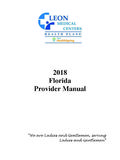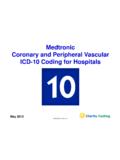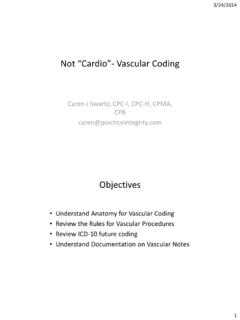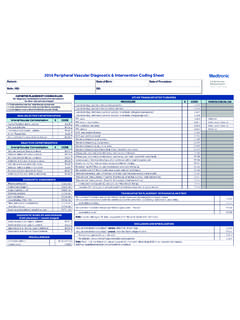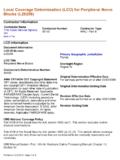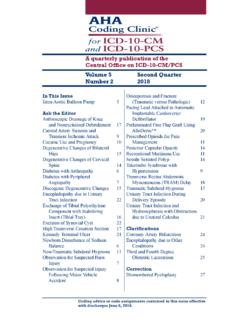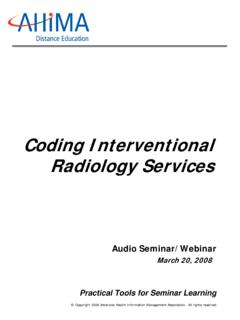Transcription of PERIPHERAL ARTERY DISEASE (PAD) - …
1 PERIPHERAL ARTERY DISEASE (ICD-10 code ) is estimated to affect 12 to 20% of Americans age 65 and older with as many as 75% of that group being asymptomatic (Rogers et al, 2011). Of note, for the purposes of this clinical flyer the term PERIPHERAL vascular DISEASE (PVD) is used synonymously with and how to screen for PADThe updated 2013 American College of Cardiology and American Heart Association guidelines for the management of patients with PAD, recommends screening patients at risk for lower extremity PAD (Anderson et al, 2013).The guidelines recommend reviewing vascular signs and symptoms ( , walking impairment, claudication, ischemic rest pain and/or presence of non-healing wounds) and physical examination ( , evaluation of pulses and inspection of lower extremities). The Trans-Atlantic Inter-Society Consensus Document on Management of PAD and Preventative Task Force on screening for PAD identify similar screening criteria that address patient s age, smoking history, co-morbid conditions and physical exam findings (Moyer, 2013 & Norgren et al, 2007).
2 The American College of Cardiology and American Heart Association guidelines further recommend obtaining an ankle-brachial index (ABI) if the patient has any of the following findings (Anderson et al., 2013): Exertional leg symptoms Non-healing wounds Age 65 years or older 50 years or older with a history of smoking or diabetesIf patient history or physical exam meets any one of the following criteria, assess if the patient can tolerate and will consent to an ABI procedure or equivalent to diagnose PADThe ABI is a ratio of ankle and brachial systolic blood pressures. The resting ABI can establish the lower extremity PAD diagnosis in patients with symptoms or with significant risk factors (Anderson et al., 2013). The American Cardiology and American Heart Association 2013 revised guidelines recommend the following interpretation for noncompression values for ABI (Anderson, 2013).Table 2: Interpretation of ABI ValuesValueInterpretation> - to moderate PADThe diagnostic accuracy of the ABI can be hindered under the following conditions: (Ruff, 2003) Patient anxiety and/or discomfort Poor positioning of patient or restless patient Exam performed in a cold room Sphygmomanometer cuff wrong size for limb or improper useEducation, treatment, and follow up of abnormal findingsAbnormal ABIs are diagnostic of PAD and can be associated with significant clinical findings and urgent diagnoses.
3 When diagnosing PAD the clinician should consider additional testing if ABI indicates non-compressible vessels and additional complaints suggesting more severe/urgent patient is using tobacco/smoking, then educate the patient about the contribution of smoking to the risk of contracting PAD. This should include smoking cessation counseling/materials. Encourage treatment and control of co-morbid chronic conditions like HTN, DM, hypercholesterolemia, and CAD. Encourage walking for exercise when not of Aspirin or other similar anti-platelet medications may prevent the development of serious complications from PAD and associated atherosclerosis. Leon Medical Centers is a registered trademark of Leon Medical Centers. 2015 Cigna INT_15_31522 07152015 PERIPHERAL ARTERY DISEASE (PAD)Provider s guide to diagnose and code PADR eferencesAnderson J, et al (2013). Management of Patients with PERIPHERAL ARTERY DISEASE (Compilation of 2005 and 2011 ACCF/AHA Guideline Recommendations).
4 A Report of the American College of Cardiology Foundation / American Heart Association Task Force on Practice Guidelines. Circulation 127, 1425-1443 Mohler E & Mitchell E (2012) Noninvasive diagnosis of arterial DISEASE . UpToDate. Retrieved 12/9/2013 Moyer V (2013). Screening for PERIPHERAL ARTERY DISEASE and Cardiovascular DISEASE Risk Assessment with the Ankle-Brachial Index in Adults: Preventative Service Task Force Recommendation Statement. Annals of Internal Medicine 159 (5) VL, Go AS, Lloyd-Jones DM, et. al. Heart DISEASE and Stroke Statistics 2011 Update: A Report From the American Heart Association. Circulation 2011;123 D (2003) Doppler assessment: calculating an ankle brachial pressure index. 99(42), 62 assessment-skills/doppler-assessment-cal culating-an-ankle-brachial-pressure- Retrieved 12/3/20132015 ICD-10-CM PVD Diagnostic CodesICD-10-CM-CodeICD-10-CM DescriptionDefinition / vascular DISEASE , specified PERIPHERAL vascular diseasesDiabetic PERIPHERAL mellitus due to underlying condition w/diabetic PERIPHERAL angiopathy(-) Add 5th character: 1 without gangrene 2 with or chemical-induced diabetes mellitus w/diabetic PERIPHERAL 1 diabetes mellitus w/diabetic PERIPHERAL 2 diabetes mellitus w/diabetic PERIPHERAL specified diabetes mellitus w/diabetic PERIPHERAL angiopathyAtherosclerosis of native arteries of the Atherosclerosis of native arteries of extremities(-) Add 6th character.
5 1 right leg 2 left leg 3 bilateral legs 8 other extremity 9 unspecified extremity of native arteries of extremities w/intermittent of native arteries of extremities w/rest of native arteries of extremities Atherosclerosis of native arteries of of native arteries of right leg w/ulceration(-) Add 6th character: 1 thigh 2 calf 3 ankle 4 heel and mid-foot 5 other part of foot 8 other part of lower leg 9 unspecified site*Use add l code to identify severity of ulcer ( ) of native arteries of left leg of native arteries of other extremities w/ulcerationUse add l code to identify severity of ulcer ( )Atherosclerosis of bypass graft of the Atherosclerosis of unspec. type of bypass graft(s) of extremitiesAdd 6th character: 1 right leg 2 left leg 3 bilateral legs 8 other extremity 9 unspecified of unspec. type of bypass graft(s) of extremities w/intermittent of unspec. type of bypass graft(s) of extremities w/rest of unspec.
6 Type of bypass graft(s) of right leg w/ulcerationAdd 6th character: 1 thigh 2 calf 3 ankle 4 heel and mid-foot 5 other part of foot 8 other part of lower leg 9 unspecified siteUse add l code to identify severity of ulcer ( ) of unspec. type of bypass graft(s) of left leg of unspec. type of bypass graft(s) of other extremity w/ulcerationUse add l code to identify severity of ulcer ( )Atherosclerosis of other types of bypass grafts of the of autologous vein bypass graft(s) of the extremities(-) Additional characters:See ICD-10-CM Code handbook for additional levels of specificity when assigning these codes*Note the additional code assignment of non-autologous biological bypass graft(s) of the of non-biological bypass graft(s) of the of other type of bypass graft(s) of the extremitiesOther and unspecified total occlusion of ARTERY of the extremitiesCoding and Documentation Guidelines Explicitly document findings to support diagnoses of PAD Document a diagnostic statement that is compatible with ICD-10-CM nomenclature Explicitly document treatment plan/follow-up Confirm face-to-face encounter is signed and dated by clinician.
7 Include printed version of clinician s full name and credentials ( , MD, DO, NP, PA) If the patient has diabetes mellitus (DM) code combination code to report DM with underlying associated PERIPHERAL angiopathy with additional levels of specificity as: Typ e 1 Typ e 2 Drug-induced With gangrene Without gangrene Atherosclerosis codes provide additional levels of specificity for: Laterality Right Left Bilateral Ulcer site Status of ARTERY and grafting material Native Bypass graft Autologous Non-autologous biological
